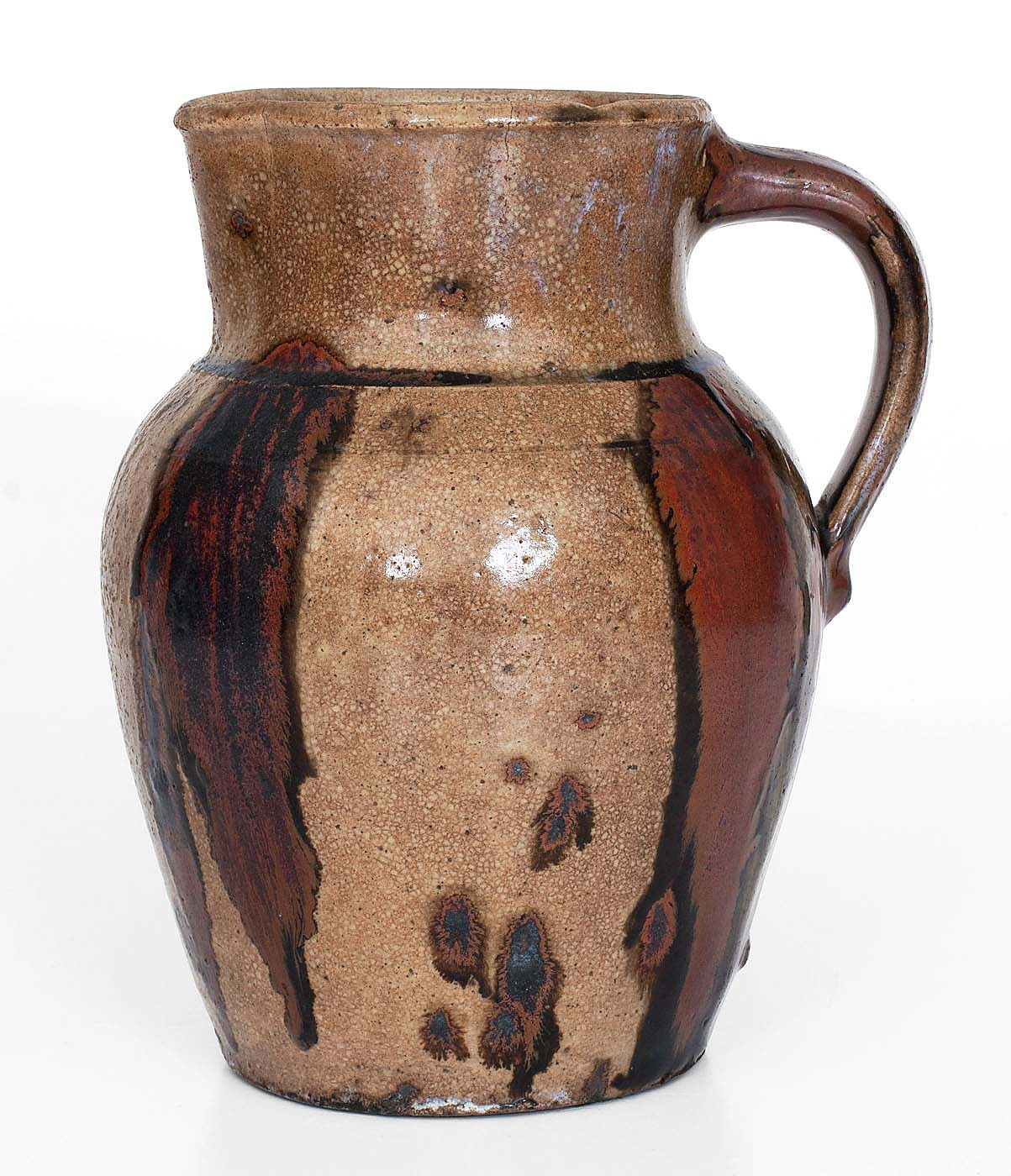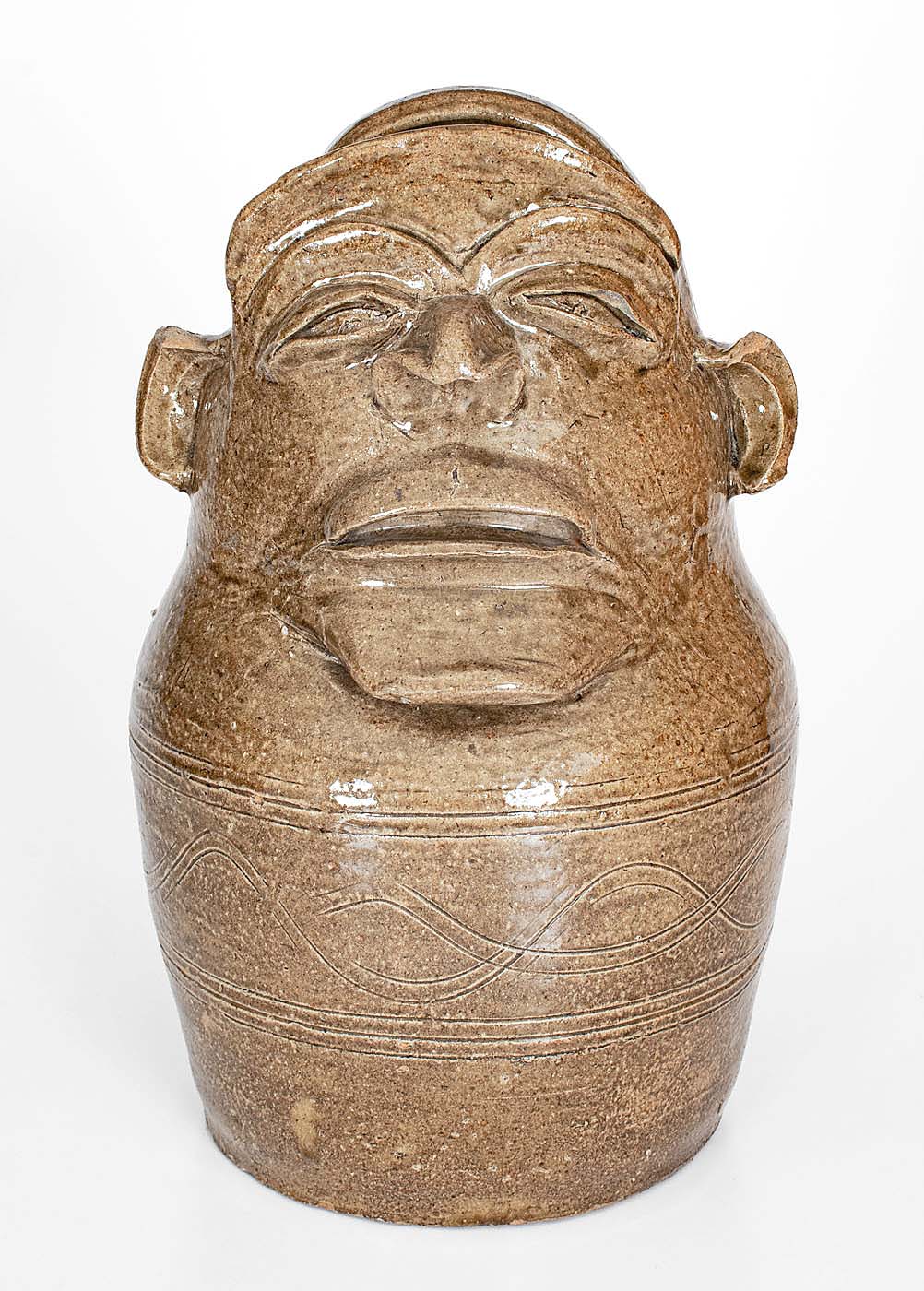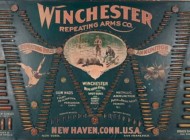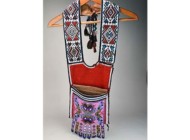
Achieving the highest price of the auction was this circa 1895 J. A. Davis face jug inscribed “The Hon. Fred Dougless.” It measured 11 inches in height and sold to an advanced folk art collector for $90,000 ($25/40,000).
Review by Carly Timpson
SPARKS, MD. — Carole Wahler, celebrated for her sophisticated collection of American stoneware and ceramics, passed away in 2023, and the first part of her collection was recently auctioned at Crocker Farm from January 31 to February 1. Mark Zipp, partner at Crocker Farm, commented: “We’ve sold to her in the past and known her for more than 20 years, but it was a privilege to handle the collection. She was a legend in the field and the prices reflect that. People wanted something from her collection and there was value in that — people were not just buying an object, they were, in essence, buying a piece of her legacy.” The sale realized about $1.34 million — more than twice the high estimate, according to Zipp. “We were very happy with the results and we’re very fortunate to be in a field that is so hot right now. It was also a great sale in that we had six different museums bidding.”
Leading the sale was a piece at the crossroads of history and design. Made circa 1895 by John A. Roberts of the Cookeville Pottery in Tennessee, a face harvest jug inscribed “The Hon. Fred Dougless” on its back side and “Negro” to its underside was the star of the auction. The piece was likely made to commemorate the abolitionist’s death in 1895 and is considered to be the maker’s masterwork. Further, “the sculptural quality, fine condition and large impressed maker’s mark found on Roberts’s Frederick Douglass jug place it among the finest face vessels known from the state of Tennessee,” according to the catalog. As Zipp said, “when you have a piece that combines both art and history in that way, you’re going to get a great price. Even without the inscription, the face jug was great, and then you also have the signature of that potter, which is rare — it was just exceptional.” He continued, “I had heard about this piece for years — it’s a legendary piece. We didn’t even know she had it and were stoked to see it when we went to pick up her collection.” The venerable jug sold to an advanced folk art collector for $90,000 — more than doubling its $40,000 high estimate.

Estimated $20/30,000 but selling to a Southern collector for $84,000, this lidded stoneware water cooler by John Floyd, 1857, 18½ inches high, is considered the maker’s “Rosetta stone.”
Possibly a unique example, a lidded five-gallon water cooler made by John Floyd at the Graves Pottery, Knox County, Tenn., in 1857 rose to $84,000. The piece was cataloged as “one of the finest examples of Tennessee stoneware known” due to its form, decoration and rare signature. Additionally, unusual attributes of the piece exemplify a migration of American ceramic traditions. Zipp told us, “It showed strong Manhattan influence even though it was made in Tennessee in the 1850s. It was an enigmatic piece and the theory is that he (Floyd) was influenced by a potter who was trained in that Manhattan style.” The catalog suggested this influence may have been John Morgan of Rockbridge County, Va., or someone else. The cooler, with its incised and cobalt-accented details, was exhibited at the Museum of East Tennessee History on several occasions and was illustrated in two books about Southern pottery.
Wahler’s important Thomas Owenby “Confederate Money” jug, so called for its inscription that read “Aug the 30 / 1864 / Maid an Sold at / A low price fore Confedrent / Money by me Thomas Ownbey,” ultimately sold to an institution for $78,000. According to the catalog, the inscription is thought to be a satirical commentary on the value of the Confederate dollar toward the end of the Civil War, providing insight into the potter’s personal views. This jug had previously belonged to Wahler’s collecting predecessor Georgeanna Greer and was the top lot in Harmer Rooke Galleries’ auction of her pottery collection in 1992, when Wahler acquired it.

Rob Hunter won this circa 1860-75 John Davis Leopard, Rusk County, Texas, alkaline-glazed stoneware pitcher with iron slip decoration, 9-3/8 inches, for $19,200 ($6/10,000).
Purchased by Wahler in that same sale was a John Davis Leopard pitcher from Rusk County, Texas. This alkaline-glazed pitcher had iron slip decoration and was made around 1860-75. According to her own notes about the lot, Wahler considered this pitcher to be the best Texas piece she had seen. This time around, it was won for $19,200 by American ceramics dealer and former editor of Ceramics in America, Rob Hunter. Hunter commented, “It’s a drop-dead gorgeous example of American pottery and would be at home in any art museum in the world. It has a wonderful collection history and a great deal of personal history, not only to Carole Wahler but to the original owner Georgeanna Greer. There’s a great two-page letter between them about how Carole appreciated both the history and aesthetics of the piece. It’s a nice touchstone to get into their minds and hearts, to see the emotional connection both Carole and Georgeanna had to this one piece.”
Hunter was also the winning bidder on a “masterwork of figural stoneware” — an Alabama torso jug. Zipp reported that this piece was “great and an incredible size. The condition was immaculate. It had an earlier glaze than you usually see in Alabama face vessels. You usually see a later Albany slip glaze or salt over Albany slip. This one had a green alkaline glaze which is unusual. This piece flew under our radar and were shocked to find it in her collection.” Hunter told us that he had personal interest in this jug, as it’s a “major sculptural piece of Southern pottery with wonderful collection history.” He referred to its provenance to three of the South’s leading stoneware collectors, Tony Shank, Pria Harmon and Wahler, noting “it’s got great DNA.” The large jug, inscribed “W” on its left side, sold for $57,000.

Cataloged as “outstanding and important,” this 17-inch-high alkaline-glazed Alabama stoneware torso jug, circa 1850-80, sold to ceramics dealer Rob Hunter for $57,000 ($20/430,00).
Hunter mentioned that he was the underbidder on a couple things, but the Texas pitcher was really what he was after from the start of the sale, and he was pleased with the results.
Several pieces of redware sold well, too, with a John Alexander Lowe jar leading the selection. A 1852-62 lead glazed jar was further accented by dipped manganese decoration. Once setting a record for a piece of Nineteenth Century Tennessee pottery when it sold at Case Antiques in 2008 for $63,000, the piece sold this time for $54,000. The catalog noted that “At the time [2008], it was the only marked example of the potter’s work known. Wahler’s extensive research on Tennessee potters has yielded a significant amount of information on Lowe’s life and career.” Lowe was an associate of Christopher Alexander Haun (1821-1861), an artistic potter and Union sympathizer who was hanged by the Confederate army.
Haun was the maker of a similar redware jar that achieved $42,000. This example, described in the catalog as having a “desirable form, excellent use of brushed and impressed decoration and elusive maker’s mark,” was made circa 1840-60, and is “among the finest jars by this potter known.” In her notes, Wahler mentioned that no other signed Haun pieces bore the same coggle wheel decoration, though similar examples were found at the site of the J. A. Lowe pottery.

From Cain Pottery, Sullivan County, Tenn., circa 1830-80, this open-handled redware jar with brown slip decoration, 9 inches, sold to an institution for $28,800 ($6/10,000).
For $28,800, a Tennessee institution bought a Cain Pottery redware jar, which was Wahler’s first major Tennessee earthenware acquisition, according to Zipp. The piece had an all-over brown-slip stripe decoration — either manganese or iron under lead — and was marked “C” for the Sullivan County, Tenn., pottery where it was made. The same institution acquired a Tennessee stoneware vase that bore an unusual inscription: “I Am From 10EC.” Zipp shared, “it’s always cool when you have that personification of the pot, with inscriptions as if the pot was talking to you. It was really charming with the message and the little code or wordplay, mixing numbers and letters to say ‘Tennessee.’ This is something I’ve never seen before. We see numbers and we see letters, but they’re never used together like this. It was also really cool because in the Index of American Design, there was an artist who painted a picture during the Federal Art Project work-relief program and the National Gallery of Art has that painting of it still. There are only a handful of inscribed pieces of Middle Tennessee brown slip, and that this one is representing the state with that message is really neat.” The vase was also marked “7” and sold for $24,000.
In closing, Zipp said, “It was a substantial collection, and we will still have another sale with her collection either in the fall of 2025 or about a year from the date of this sale.” Crocker Farm’s next auction will run April 2-11.
Prices quoted include the buyer’s premium as reported by the auction house. For information, www.crockerfarm.com or 410-472-2016.




















